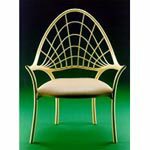John Makepeace
John Makepeace O.B.E.
John's adventure in wood has evolved from an early fascination, stimulated by his first sight of fine contemporary furniture at eleven and teenage visits to the great Danish designers and workshops in the 1950s. His training was preceded with the warning "Do not expect to make a living from furniture making". That, and his subsequent study and consultancy tours led repeatedly to the question, "Why?". Gradually, the young craftsman came to realise that the answer lay in poor creativity and management of furniture workshops, elements he sought to address in his own practice and in the education of others.
The Makepeace workshop has received commissions for the permanent collections of Cardiff and Birmingham City Art Galleries, The Fitzwilliam Museum, Cambridge, The Victoria and Albert Museum, The Royal Scottish Museum, Edinburgh, The Museum for Kunsthandwerk, Frankfurt and The Art Institute, Chicago. Apart from the 24 rooms for Templeton College, , Liberty's Centenary Dining Room and the boardroom for Banque Generale du Luxembourg for example, his furniture is made predominantly for private clients in Europe and the United States.
The purchase of Parnham in 1976 afforded the space to accommodate the growing order book, a historic house to show modern furniture to a sceptical public, and facilities for an independent residential School for Craftsmen in Wood, later to become Parnham College. The object of the school was to meet the need for an integrated education in making, design and business skills for those wishing to become professional furniture makers alongside, but a separate entity from, the Makepeace design-workshops.
By 1983, the economics and sustainability of indigenous timber growing were pressing issues. The Parnham Trust purchased Hooke Park, a 350 acre mixed woodland, to research, demonstrate and teach the better use of forest produce, especially thinnings. A series of buildings was required for the future campus. Designed by eminent architects and engineers, each was the result of a two year European research programme, leading to new technologies which exploit timber's best properties and combine it with other materials which compensate for its innate weakenesses. The construction of the buildings demonstrates priniciples directly applicable to furniture making.
After 25 years running the Trust, John resigned as Director in 2000 in order to return to his passion for designing and making furniture. The aim of the Makepeace Studio is "To extend the boundaries of function, structure and expression beyond those normally associated with furniture".
Prospective clients are invited to visit the website, and if feasible, the gallery and studio in Beaminster, by appointment. Alternatively you may prefer to meet him on your own ground. You are welcome to contact him for a preliminary discussion.
